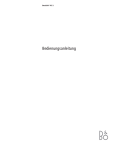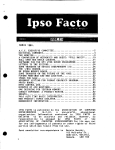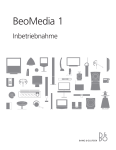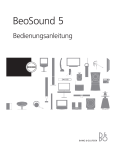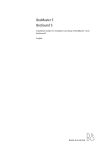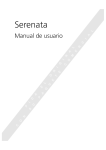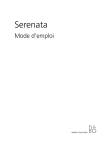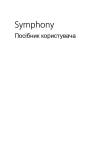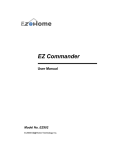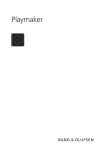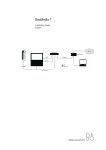Download Bang & Olufsen BeoPort Setup guide
Transcript
BeoPort Guide CAUTION RISK OF ELECTRIC SHOCK DO NOT OPEN CAUTION: To reduce the risk of electric shock, do not remove cover (or back). No User-serviceable parts inside. Refer servicing to qualified service personnel. WARNING: To reduce the risk of fire or electric shock, do not expose this appliance to rain or moisture. Do not expose this equipment to dripping or splashing and ensure that no objects filled with liquids, such as vases, are placed on the equipment. To completely disconnect this equipment from the AC Mains, disconnect the power supply cord plug from the AC receptacle. The lightning flash with arrowhead symbol within an equilateral triangle, is intended to alert the user to the presence of uninsulated “dangerous voltage” within the product’s enclosure that may be of sufficient magnitude to constitute a risk of electric shock to persons. The exclamation point within an equilateral triangle is intended to alert the user to the presence of important operating and maintenance (servicing) instructions in the literature accompanying the product. Acknowledgement and liability Product names mentioned in this Guide may be trademarks or registered trademarks of other companies. – Music recognition technology and related data are provided by Gracenote ® and the Gracenote CDDB ® music recognition service. Gracenote is the industry standard in music recognition technology and related content delivery. For more information visit www.gracenote.com. – Music-related data from Gracenote and Gracenote CDDB Client Software © 2003, all rights reserved. This product and service may practice one or more of the following U.S. Patents: #5,987,525; #6,061,680; #6,154,773; #6,161,132; #6,230,207; #6,230,192; #6,240,459; #6,330,593 and other patents licensed, issued or pending. Services may be supplied and/or device manufactured under license from Open Globe, Inc. for U.S. Patent #6,304,523. – The Gracenote CDDB Service uses a unique identifier to track queries for statistical purposes. The purpose of a randomly assigned numeric identifier is to allow the Gracenote CDDB service to count queries without knowing anything about who you are. For more information, see the web page for the Gracenote Privacy Policy for the Gracenote CDDB Service. Gracenote, CDDB, the Gracenote logo, and the CDDB logo, are all registered trademarks of Gracenote. The “Powered by Gracenote” logo is a trademark of Gracenote. Portions based upon Microsoft Windows Media Technologies. Copyright© 2000 Microsoft Corporation. All rights reserved. Microsoft, Windows Media and the Windows Logo are registered trademarks of Microsoft Corporation in the United States and/or other countries. MicroOS Operating System (U.S. Patent #5,787,445) Please note that Bang & Olufsen will, in no event, be liable for any consequential, incidental or indirect damages arising out of the use or inability to use the software. Note to installer This reminder is provided to call your attention to Article 820-22 of the National Electrical Code (Section 54 of Canadian Electrical Code, Part 1) which provides guidelines for proper grounding and, in particular, specifies that the cable ground shall be connected to the grounding system of the building as close to the point of cable entry as practical. For your safety – Do not mount BeoPort with the cable connections turning downwards. Keep BeoPort away from water and do not place items on top of it. The mains plug enables the separation (switch off) from the net voltage. The wall outlet has to be close to the device and must be easily accessible. – Avoid placing your BeoPort in direct sunlight or direct artificial light (e.g. a spotlight). BeoPort is developed for indoor use in dry, domestic environments only, and for use within a temperature range of 10–40° C (50–105° F). – Do not attempt to open BeoPort. Leave such operations to qualified service personnel. CAUTION: To prevent electric shock do not use the polarized plug with an extension cord, receptacle or other outlet unless the blades can be fully inserted to prevent blade exposure. Contents This Guide provides you with a complete overview of installation, basic aspects about configuration, and the principles of daily use. We recommend that you follow the listed sequence in the chapter Before you start… on page 5. In addition to this Guide, BeoPort contains an On-Screen Guide, accessible once you have installed BeoPort. Before you start…, 5 Follow this sequence of instructions to ensure flawless installation and fast access to BeoPort. This chapter also includes a list of system requirements. Setting up BeoPort, 6–7 Find out how you can set up your BeoPort, what Option number setting is all about, and how to connect the cables. Installing BeoPort, 8–9 Choose between an installation with or without a TV tuner card. You can also find out how to repair or upgrade your BeoPort installation. Configure BeoPort, 10–11 Find out how to make the configuration settings you need. This chapter shows you some basic settings, and explains registration of BeoPort. Daily use, 12 Starting out. Before you can play N.MUSIC…, 13 How to scan for music tracks already stored on your PC. Index, 14 3 4 Before you start… To ensure a successful BeoPort installation, follow the sequence of instructions on this page exactly. 5 1 Make sure that your setup meets the requirements listed below 2 Setup your BeoPort (p. 6) 3 Connect BeoPort (p. 7) 4 Install BeoPort, including TV tuner card and driver (pp. 8–9) 5 Configure BeoPort (p. 10) 6 Register (p. 11) BeoPort requirements To be able to install the BeoPort application, your PC must meet the following requirements: Hardware requirements – Pentium-class PC (233 MHz or above) with 50 MB available disk space – Min. 64 MB RAM – Super VGA monitor with a minimum resolution of 800 × 600 and 16-bit colour depth – One available USB socket Operating system requirements – Windows 2000 or XP – DirectX 8.0a or newer – Media Player 9.0 or newer Browser requirements – Internet Explorer version 4.01 or newer Browser configuration requirements Select the following preferences in Explorer Support: – Download signed ActiveX controls – Run ActiveX controls – Script ActiveX controls marked safe for scripting – Utilize active scripting TV tuner card If you have a TV tuner card, make sure that it is supported by BeoPort. For continuous updates on compatible TV tuner cards, refer to www.beoplayer.com. Note that some TV tuner cards may necessitate that your PC meets other hardware requirements than those listed above. Refer to the tuner card documentation for this information. Setting up BeoPort 6 BeoPort can be set up in a variety of ways with other linkable Bang & Olufsen products. The example on this page shows one of many setup possibilities, as well as the connections you need to make for this setup. OPTION 6 Note that the use of video sources has limitations in some countries. Contact your retailer for further information. Turn to the next page for details about connecting BeoPort. All connections except the USB connection must be made before you install the BeoPort software. BeoPort – in a Bang & Olufsen system setup Option number setting For a setup to function, the BeoPort box and any link products included in the setup must “know” in what kind of environment they are placed. To ensure this, you simply select an Option number for each product in your setup. You select the Option number for BeoPort in the Configuration menu, once you have finished the installation process. Refer to Configuration (p. 11). Regarding ‘Option’ number setting of link products, refer to the documentation enclosed with these products. BeoPort – in a Bang & Olufsen system setup The setup shown above is a typical example of a system setup. In this example the BeoPort box must be set to Option number 6, which is the default setting. From your PC in one room, you can listen to either main room or link room sources. If you wish, the audio signals can be distributed to additional link rooms throughout the house and to the main room. With a connected IR receiver, you can operate your system with a Beo4 remote control. To be able to remote control your sources via BeoPort, your PC must be turned on. Additional Options for the BeoPort box In addition to Option number 6, it is possible to select Option numbers 0, 2 and 4. Option number 0 is for a setup where you want to disable an IR receiver. Option 2 is for a setup where you want to use your PC as a main room product. Option 4 is for a setup with link room products placed in the same room as the main system. The use for these Options is limited, but your retailer can be contacted for further information about Option number selection. 7 Master Link connection to a Bang & Olufsen system Power Link connection IR receiver connection IR Mains connection USB AUDIO IN USB connection POWER LINK MASTER LINK Audio connection to the PC sound card AUDIO OUT Master Link connection A Master Link connection enables you to distribute signals between your PC and Bang & Olufsen products throughout your home. IR receiver connection The IR socket is used for connecting an optional IR receiver to your PC. This enables you to operate your different sources directly with a Beo4 remote control. Power Link connection The Power Link socket is used for connecting Power Link speakers to your BeoPort setup. Mains connection Connect attached products, speakers, your PC and the BeoPort box to the mains. For safety reasons, always connect the BeoPort box (and all your PC equipment) to a grounded wall outlet. Audio connection The audio connection between the BeoPort box and the PC sound card allows for the transmission of analogue sound from the PC to your connected products. USB connection Connect the BeoPort box to the PC with the enclosed USB cable. IMPORTANT! It is crucial that you do not make the USB connection until you are specifically prompted to do so on the screen. You do not have to turn off the PC to connect this cable. The BeoPort box should be fastened to the wall or the back of your PC desk/furniture. Install BeoPort 8 Once you have inserted the BeoPort CD-rom into your CD-rom drive, the BeoPort installation menu appears on the screen. Select Install BeoPort to initiate the installation process. During this process you will be asked to decide whether you want to make an installation with a TV tuner card, or an installation without a TV tuner card. Choose the latter, if you either have a compatible, already working, TV tuner card installed, or if you don’t want to be able to watch TV on your PC screen. You can always install a TV tuner card at a later time. The installation menu also contains information about system requirements and compatible TV tuner cards. NOTE! In case the installation menu does not appear automatically when the CD-rom is inserted, select Run from the start menu and write X:\InstallGuide.exe in the command line, substituting the X with the driveletter of your CD-rom drive. The Installation process > Select BeoPort installation from the menu. > Follow the instructions on the screen carefully. > When prompted to install the TV tuner card, mount the card according to the instructions supplied with the card. > Connect the tuner card with the sound card using the audio cable supplied with the tuner card. At the end of the BeoPort installation process you will be prompted to connect the USB cable from the BeoPort box to the PCs USB connector. > Make the USB connection when prompted, not before! When you have installed the software, the BeoPort Configuration program starts automatically. It may be necessary to remove an already mounted graphics card, in which case the TV tuner card will function as both TV tuner and graphics card. This will initiate the installation of the USB driver for BeoPort. If you have a previous installation of BeoPlayer, BeoLink PC Office or BeoLink PC 2, this software will automatically be removed to avoid conflicts. 9 To repair or upgrade your BeoPort installation Should elements of your BeoPort be missing, if e.g. files have been deleted, you can use the installation program to repair or upgrade your installation. > Select Run from the start menu and write X:\installguide.exe in the command line, substituting the X with the drive letter of your CD-rom drive. > In the Installation menu, select Repair/ upgrade your installation. If the program registers that you already have BeoPort installed on your PC, you will enter the BeoPort Maintenance program. > Select whether you want to repair or upgrade or remove your current installation. > Click Next to continue. > Follow the instructions on the screen to complete the chosen task. Configuration of BeoPort 10 Make your settings and adjustments for BeoPort in the Configuration menu*. This chapter tells you what to do, to be able to watch PC TV, including how to make the correct Option number setting. In addition, the Configuration menu contains a variety of choices which, depending on your specific setup, may be necessary to consider. Therefore, we urge you to click through the ‘Configuration menu’ and refer to the instructions in the On-Screen Guide for additional information. Once you have initially configured BeoPort, you are prompted to register, as described on the opposite page. Auto-tuning Before you auto-tune TV channels for your TV tuner card, make sure that the correct broadcast system is displayed under ‘Video System’, that you have indicated whether your connection is via cable or antenna, and that the correct country is displayed. Remember that to receive a transmission, antenna or cable must be connected directly to your PC. From the ‘BeoPort Configuration’ menu… > Click the Tune tab to be able to tune and make presets. > Click AutoTune to start auto-tuning TV channels. During the tuning sequence, the located channels are shown in the display. At any time, you can stop the tuning and the channels already found will be stored. Manual tuning If you want to tune in a channel manually, perhaps because it was not found during auto-tuning, go to the section Manual in the Tune menu. > In the section Manual, use the small arrows to click through the channels. > When you have found the channel you want to add, click Add. On the TV tuner cards, the TV channels you tune in are registered as program numbers and channels. Please note that not all TV tuner cards observe standard channel numbers for TV channels. *NOTE! The BeoPort Configuration menu appears automatically when you install BeoPort. To access this menu at a later date, select CONFIG under SETUP on the control bar. To access the On-Screen Guide, select GUIDE in the control bar. The ‘Tune’ tab in the Configuration menu. The ‘Advanced’ tab in the Configuration menu. 11 Option setting Registration of BeoPort It is important that BeoPort is set to the correct Option, corresponding with your setup. Once you have initially configured BeoPort, you are prompted to register, if you have access to the Internet at that time. Although you can use BeoPort without it, registration is necessary in order to receive the service provided by CDDB*. Naturally, Bang & Olufsen handles the information provided during registration with utmost confidentiality. To make an Option number setting… > Select CONFIG to access the menu. > Select the Advanced tab to call up Option settings. > Select the appropriate Option number from the list; 0, 2, 4 or 6. For further information about Option setting, refer to page 6. If you have not registered… A registration form automatically appears on screen. > Click New User and fill out the form. If you have already registered… > Enter your User Name and E-mail address. In order to receive CDDB information, your PC must be connected to the Internet and be online. If you have no Internet access, you are not prompted to register, but if you obtain Internet access at a later date, you will be prompted to register. *CDDB is a storage and distribution service for music information. CDDB is a service of GraceNote, Int. The information you can receive from the CDDB database, is the ‘tag’ information, which often accompanies your N.MUSIC tracks, such as artist name and album title. Be aware that the service will only function properly if your internet connection is open while you use BeoPort. Daily use 12 Once BeoPort is installed, call up the control bar – your navigator for all BeoPort functions. < PC TV Starting out Click on the B&O icon short-cut in your System tray to start up BeoPort. Move your mouse cursor to the far right and click the triangular tab (shown to the right) to call up the control bar. > PC TV N.MUSIC PC CD Click to switch on a source such as PC TV. If < > appears around a source – as shown to the left, then click on < or > to reveal additional sources. Status display – indicates the current source and channel, station or track number. Short-cuts The B&O icon is inserted automatically in the System tray, once the BeoPort application is installed. Click m or p to step up or down through for example TV channels, CD tracks etc. Click or to wind backwards or forwards on a CD or a tape, or to step from CD to CD. If you close the application, then start BeoPort from the BeoPort directory in your Start menu, or use the B&O icon short-cut in your System tray. PHOTO m N.RADIO PC TV p The coloured buttons operate functions specific to the chosen source. PC TV GO GO Click to resume playback of a paused source. STOP STOP < r MUTE u Click to pause playback of a source. > Click to adjust volume up or down – click MUTE between r and u to mute the sound, and click a volume button to restore the sound. Click < or > to reveal MUTE HP and click this button to mute your headphones. SETUP GUIDE SETUP Click to view individual options depending on the chosen source. GUIDE Click to access the On-Screen Guide. • Switch to standby – click and hold • for 2 seconds to switch off all sources. Click • twice to close the BeoPort control bar and application. NOTE! The control bar changes appearance when you switch sources, making the appropriate options available for the active source. For further information, refer to the On-Screen Guide. Before you can play N.MUSIC N.MUSIC is the Bang & Olufsen term for music stored on a PC, music obtained, for example, from the Internet or from audio CD’s. This chapter describes what you need to do, before you can play N.MUSIC. Once you have performed a scan as shown on this page, simply refer to ‘Daily use’ for further information, as well as to the Onscreen Guide for in-depth instructions. Scan your PC for tracks When you select the source N.MUSIC for the first time, you are prompted to search your computer for playable tracks*. A scan must be performed the first time you want to play N.MUSIC, as well as the first time a particular drive is used for track storage. The SCAN OPTIONS menu appears on the screen… > Move the cursor to the input box by a relevant drive. > Click once to set a check mark by the drive, and twice to remove a check mark. > Click START to begin a scan. Progress is shown in red below the drive selection box. > Click STOP to cancel a scan in progress. > Click HIDE SCAN to conceal the SCAN OPTIONS menu. Scans in progress will continue until they are complete. 13 SCAN OPTIONS Games (C:) System (D:) Compact disc (E:) Work (G:) START STOP HIDE SCAN When scanning is complete… > Click N.MUSIC on the control bar to begin playback of the first track. If your existing tracks contain ‘tagging’ information, such as artist names, track and album names, or genres, this information is stored during a scan. *NOTE: Once you have accessed N.MUSIC for the first time, a hidden update of your available music on the drives you initially stored on will be made every time you access N.MUSIC. Therefore, it is only necessary for you to scan your hard drive again, if you choose to store music on another drive. 14 Index Beo4 remote control Option IR receiver in a system setup, 6 What is Option setting?, 6 CDDB Requirements CDDB information and registration, 11 Hardware, operating system, browser, and TV tuner card requirements, 5 Configuration Registration Auto-tuning the TV tuner card, 10 Calling up the Configuration menu, 10 Manual tuning of the TV tuner card, 10 Option setting, 6 and 11 Register your BeoPort, 11 Scan Connections Scan your PC for tracks, 13 Master Link, Power Link, Audio, USB, IR receiver, and Mains connection, 7 Setup Daily use, 12 Locate the Configuration menu, 10 BeoPort in a Bang & Olufsen system setup, 6 Option settings, 6 Placing the BeoPort box, 7 Setup button on the control bar, 12 Driver Sound adjustment Driver installation, 8 Mute, 12 Mute Headphones, 12 Control bar Install TV tuner card Driver installation, 8 Installation, 8 Repair or upgrade installation, 9 TV tuner card installation, 8 Configuration of TV tuner card, 10 Tuner card requirements, 5 USB N.MUSIC What is N.MUSIC?, 13 Scan your PC for tracks, 13 On-Screen Guide Call up the Guide on the control bar, 12 USB connection, 7 When to make the USB connection, 8 NOTE: This equipment has been tested and found to comply with the limits for a class B digital device, pursuant to part 15 of the FCC Rules. These limits are designed to provide reasonable protection against harmful interference in a residential installation. This equipment generates, uses and can radiate radio frequency energy and, if not installed and used in accordance with the instructions, may cause harmful interference to radio communications. However, there is no guarantee that interference will not occur in a particular installation. If this equipment does cause harmful interference to radio or television reception, which can be determined by turning the equipment off and on, the user is encouraged to try to correct the interference by one or more of the following measures: – Reorient or relocate the receiving antenna – Increase the separation between the equipment and receiver – Connect the equipment into an outlet on a circuit different from that to which the receiver is connected – Consult the retailer or an experienced radio/ TV technician for help Waste Electrical and Electronic Equipment (WEEE) – Environmental protection The European Parliament and the Council of the European Union have issued the Waste Electrical and Electronic Equipment Directive. The purpose of the Directive is the prevention of waste of electrical and electronic equipment, and to promote the reuse and recycling and other forms of recovery of such waste. As such the Directive concerns producers, distributors and consumers. The WEEE directive requires that both manufacturers and end-consumers dispose of electrical and electronic equipment and parts in an environmentally safe manner, and that equipment and waste are reused or recovered for their materials or energy. Electrical and electronic equipment and parts must not be disposed of with ordinary household refuse; all electrical and electronic equipment and parts must be collected and disposed of separately. Products and equipment which must be collected for reuse, recycling and other forms of recovery are marked with the pictogram shown. This class B digital apparatus meets all requirements of the Canadian InterferenceCausing Equipment Regulations. When disposing of electrical and electronic equipment by use of the collection systems available in your country, you protect the environment, human health and contribute to the prudent and rational use of natural resources. Collecting electrical and electronic equipment and waste prevents the potential contamination of nature with the hazardous substances which may be present in electrical and electronic products and equipment. Your Bang & Olufsen retailer will assist with and advise you of the correct way of disposal in your country. This product fulfils the conditions stated in the EEU directives 89/336 and 73/23. Technical specifications, features and the use thereof are subject to change without notice. 3508614 0511 Printed in Denmark by Bogtrykkergården a-s, Struer www.bang-olufsen.com
















